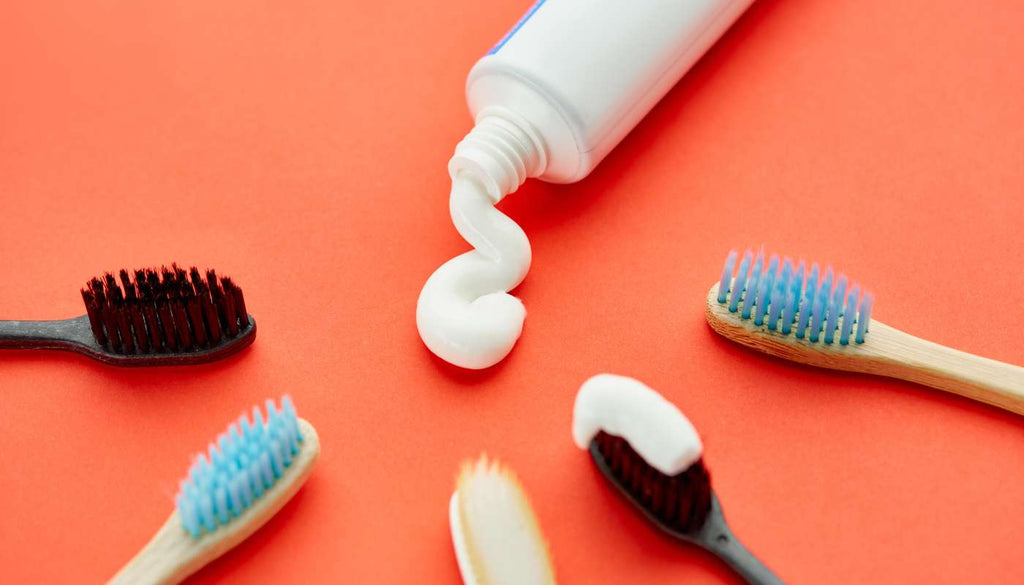
Fluoride in Toothpaste: Yes or No?
Do we really need fluoride in toothpaste? Many places in Australia have had fluoridated water since the 1950s (although it varies by region). The government has decided that this practice is safe and beneficial. If we’re already drinking fluoride in our water, why do we need to use more in our toothpaste?

How does fluoride in toothpaste work?
Acids produced by plaque eat away at the minerals in your tooth enamel, causing little cavities. Your body can remineralise these spots, filling them in while they’re still small. Fluoride applied topically several times a day speeds up the process. It also helps form bigger mineral crystals that are more resistant to acids.
How does fluoride help protect teeth?
The fluoride in fluoridated water affects children’s tooth buds. While the teeth are still developing, the fluoride replaces some of the minerals. Instead of hydroxyapatite, which our teeth are normally made of, it creates fluoroapatite, which is more resistant to tooth decay. There is some doubt about how well this process works, and whether drinking fluoridated water helps prevent tooth decay in adults at all. A 2015 review by the Cochrane Collaboration, a respected group of doctors and researchers, found that many studies supporting the effectiveness of fluoridated water were flawed. They only found three studies since 1975 that they considered any good. These studies showed that fluoridated water made no difference in the prevention of tooth decay. And too much fluoride in your toothpaste and your drinking water can have side effects.
What is fluorosis?
Fluorosis is a mottling of tooth enamel caused by consuming too much fluoride. It’s not just cosmetically unpleasant. It’s a sign that your entire body has been over exposed to fluoride, which may be building up in your system. If you take in more than 10 mg of fluoride a day over a long period of time you’re at risk for skeletal fluorosis, a debilitating bone disease.
Fluoride and your health
Back in the early part of the 20th century fluoride was used to treat hyperthyroidism, since it depresses the thyroid. A 2018 study of 10,000 people shows a strong correlation between fluoride intake and lowered thyroid function, even at levels as low as 0.3 mg/L. For reference, the levels in Australian fluoridated water vary between 0.6 and 1.1 mg/L. If you're concerned about your thyroid health, or have any family history of thyroid disease, you might want to think about avoiding fluoride altogether. (A reverse osmosis filter can get it out of your drinking water.) Many foods contain fluoride too. Tea is the biggest culprit. It can have as much as 9 mg/L. Red wine, raisins and seafood like crab and prawns may also contain a lot of fluoride. If you have a healthy thyroid, using fluoride toothpaste should be fine. Just don't swallow any!
Is fluoride toothpaste safe for babies and toddlers?
Up until the age of five or six, always supervise your children when they're brushing their teeth to make sure they spit it out properly. If you choose a children's toothpaste with fluoride, only use a tiny amount, the size of a grain of rice. Fluoride in toothpaste is poisonous in large doses. More is not better in this case. With children under three, you should carefully wipe the toothpaste off their teeth and the inside of their mouth. Or just use fluoride free toothpaste instead. When choosing your children’s toothpaste, try to go for something with a clean, simple flavour and packaging. Toothpaste that’s flavoured like lollies and decorated with cartoon animals can be almost irresistible. Kids think, ‘If it looks and tastes like lollies, why can’t I eat it?’
Do we really need fluoride?
The plaque germs that cause tooth decay love to feed on sugar and processed carbohydrates, like white flour. Cut down on your sugar intake and you’ll have less plaque. Sugary drinks are especially bad. You can prevent a lot of tooth problems by simply cutting out soft drinks and sweetened drinks. Even fruit juice can harm your teeth. It won’t help to drink a can of soft drink and rush off to brush your teeth. When you eat or drink anything acidic, like soft drink, pickles or beer, your tooth enamel softens a bit. It’s a good idea to wait at least 30 minutes for your mouth to return to normal before you subject your teeth to the abrasiveness of brushing. Of course, you should brush after every meal, or at least twice a day. Just wait a little while if you had spaghetti bolognese and oranges for dinner. Chewing sugar free gum can help protect your teeth as well. Xylitol, a low calorie sweetener made from plants, neutralises acid in your mouth and helps remineralise your teeth. Don’t use too much, though! (It can have a laxative effect.)
If you eat well, take care of your teeth and see your dentist regularly, there’s no reason you shouldn’t use fluoride free toothpaste if you want to. We have many brands to choose from. You'll also find great natural toothpastes with fluoride, like these ones from Lavera and The Humble Co. Grants of Australia also offers many natural toothpaste options for kids and adults, with or without fluoride.
Want to learn more about natural dental care? You can also read our shopping guide for all natural dental products.




